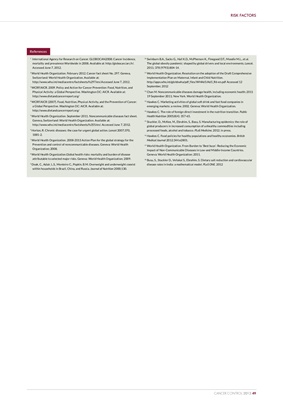
RISK FACTORS
References
1. 10.
International Agency for Research on Cancer. GLOBOCAN2008: Cancer Incidence, Swinburn B.A., Sacks G., Hall K.D., McPherson K., Finegood D.T., Moodie M.L., et al.
mortality and prevalence Worldwide in 2008. Available at: http://globocan.iarc.fr/. The global obesity pandemic: shaped by global drivers and local environments. Lancet.
Accessed June 7, 2012. 2011; 378 (9793):804-14.
2. 11.
World Health Organization. February 2012. Cancer fact sheet No. 297. Geneva, World Health Organization. Resolution on the adoption of the Draft Comprehensive
Switzerland: World Health Organization. Available at: Implementation Plan on Maternal, Infant and Child Nutrition.
http://www.who.int/mediacentre/factsheets/fs297/en/.Accessed June 7, 2012. http://apps.who.int/gb/ebwha/pdf_files/WHA65/A65_R6-en.pdf Accessed 12
3.
WCRF/AICR. 2009. Policy and Action for Cancer Prevention: Food, Nutrition, and September, 2012
12.
Physical Activity: a Global Perspective. Washington DC: AICR. Available at: Chan M. Noncommunicable diseases damage health, including economic health; 2011
http://www.dietandcancerreport.org/ 19 September 2011; New York. World Health Organization.
4. 13.
WCRF/AICR (2007). Food, Nutrition, Physical Activity, and the Prevention of Cancer: Hawkes C. Marketing activities of global soft drink and fast food companies in
a Global Perspective. Washington DC: AICR. Available at: emerging markets: a review. 2002. Geneva: World Health Organization.
http://www.dietandcancerreport.org/ 14.
Hawkes C. The role of foreign direct investment in the nutrition transition. Public
5.
World Health Organization. September 2011. Noncommunicable diseases fact sheet. Health Nutrition 2005;8(4): 357-65.
Geneva, Switzerland: World Health Organization. Available at: 15.
Stuckler, D., McKee, M., Ebrahim, S., Basu, S. Manufacturing epidemics: the role of
http://www.who.int/mediacentre/factsheets/fs355/en/. Accessed June 7, 2012. global producers in increased consumption of unhealthy commodities including
6.
Horton, R. Chronic diseases: the case for urgent global action. Lancet 2007;370, processed foods, alcohol and tobacco. PLoS Medicine. 2012; in press.
1881-2. 16.
Hawkes C. Food policies for healthy populations and healthy economies. British
7.
World Health Organization. 2008-2013 Action Plan for the global strategy for the Medical Journal 2012;344:e2801.
Prevention and control of noncommunicable diseases. Geneva: World Health 17.
World Health Organization. From Burden to ‘Best buys’: Reducing the Economic
Organization; 2008. Impact of Non-Communicable Diseases in Low-and Middle-Income Countries.
8.
World Health Organization.Global health risks: mortality and burden of disease Geneva: World Health Organization; 2011.
attributable to selected major risks. Geneva: World Health Organization; 2009. 18.
Busu, S., Stuckler D., Vellakal S., Ebrahim, S. Dietary salt reduction and cardiovascular
9.
Doak, C., Adair, L.S., Monteiro C., Popkin, B.M. Overweight and underweight coexist disease rates in India: a mathematical model. PLoS ONE. 2012
within households in Brazil, China, and Russia. Journal of Nutrition 2000;130.
CANCER CONTROL 2013 49